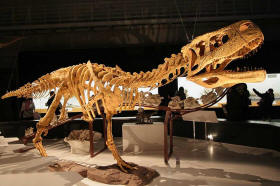|
Carnotaurus
was a large theropod, about 7.6 m (25 ft) in length, with weights varying
between 1,488 kg and 2,626 kg (1.6-2.9 short tons), depending on the
individual. The most distinctive features of
Carnotaurus are the two thick horns above the
eyes, and the extremely
reduced forelimbs with four basic digits, though
only the middle two of these ended in finger bones, while the fourth was
splint-like and may have represented an external 'spur.' The fingers
themselves were fused and immobile, and lacked claws.
It is also characterized by its unusually long neck (compared to other
abelisaurs), and its small head with box-shaped jaws. The eyes of
Carnotaurus faced forward,
which is unusual in a dinosaur, and may indicate binocular vision and depth
perception.
There is a rather puzzling contrast
between Carnotaurus’
deep, robust-looking skull and its shallow, slender lower jaw. So far no-one
has worked out what this might imply about its methods of feeding.
A single nearly complete skeleton
has been described including impressions of skin along almost the entire
right side, that show Carnotaurus
lacked feathers, unlike the more advanced
coelurosaurian
theropods. Instead, the skin is lined with rows of bumps, which become
larger toward the spine.
Related Dinosaurs
The type species
Carnotaurus sastrei is the
only known species. Its closest relatives include
Aucasaurus (Argentina),
Majungasaurus
(Madagascar), and
Rajasaurus (India).
Together, these dinosaurs form the
subfamily
Carnotaurinae in the
family
Abelisauridae. Among
the carnotaurines, Carnotaurus
is most closely related to Aucasaurus,
and together these two genera form the
tribe
Carnotaurini.
Aucasaurus
Aucasaurus
was a medium-sized theropod
dinosaur from Argentina that lived during the
Santonian
stage (Anacleto
Formation). It was smaller than the related
Carnotaurus, although
more derived in some ways, such as its extremely reduced arms and almost
total lack of fingers. The type skeleton is complete to the thirteenth
caudal vertebra, and so
is relatively well understood, and is the most complete
abelisaurid yet
described. However, the skull is damaged, causing some
paleontologists to
speculate that it was involved in a fight shortly prior to death.
Rajasaurus
Rajasaurus
(meaning "prince" or "princely lizard") is a carnivorous
abelisaurian
dinosaur with an unusual head crest. Between 1982 and
1984, its fossilized bones were discovered by Suresh Srivastava of the
Geological Survey of India (GSI). Excavated from the Narmada River valley in
Rahioli in the
Kheda district of
Gujarat, India, the
find was announced as a new genus of dinosaur by American and Indian
scientists on August 13, 2003.
Rajasaurus
was an abelisaurid,
a member of a group of theropod
predators known to have lived only on landmasses that
were part of the supercontinent
Gondwana, such as
Africa, India, Madagascar, and South America.
Rajasaurus is
distinguished from other genera by its single nasal-frontal horn, the
proportions of its supratemporal fenestrae
(holes in the upper rear of the skull), and the form of the ilia (principle bones of
the hip).
In Popular Culture
Since the mid-1990s,
Carnotaurus has been
featured occasionally in the popular media. One of its earliest prominent
roles in fiction was the 1995 sequel to
Jurassic Park, Michael Crichton's The Lost
World. In the novel, Carnotaurus
was portrayed as having the (completely fictional) ability to change its
color to blend into the background, like a chameleon or a cuttlefish.
While it did not appear in the 1997 film adaptation of the novel,
Carnotaurus subsequently
appeared in numerous tie-ins to the Jurassic
Park franchise, including several video games.
Another prominent movie role for Carnotaurus
came with the 2000 Walt Disney animated film
Dinosaur, which featured two
Carnotaurus attacking a
large herd of herbivorous dinosaurs. The
Carnotaurus in the film were much larger than
the real life animal, scaled up to proportions more closely resembling the
giant theropod Tyrannosaurus.
In reality, Carnotaurus
was even smaller than Iguanodon,
the main dinosaur featured in the Disney picture.
A Dinosaur thrill
ride at Disney's Animal Kingdom Park at Walt Disney World, also features
audio-animatronics of a Carnotaurus,
in addition to a cast of other dinosaurs.
Return to the
Old Earth Ministries Online Dinosaur
Curriculum homepage.

Shopping
Bay
State Replicas - 1/4th scale Carnotaur skull
|



